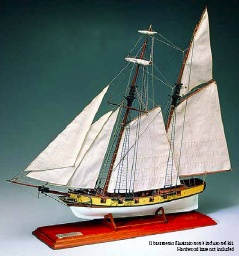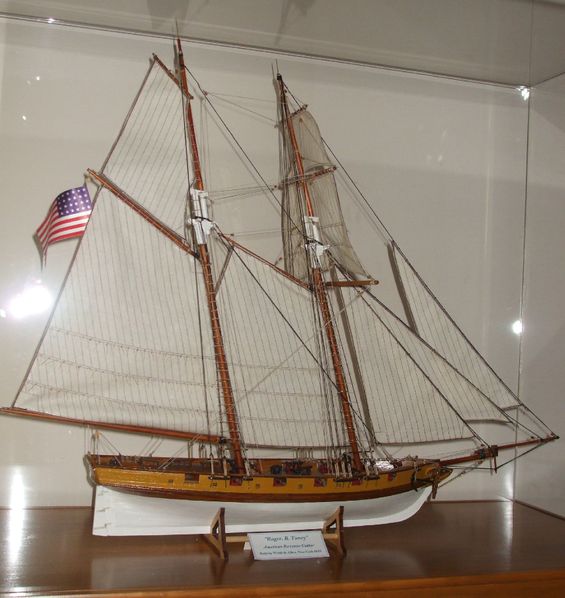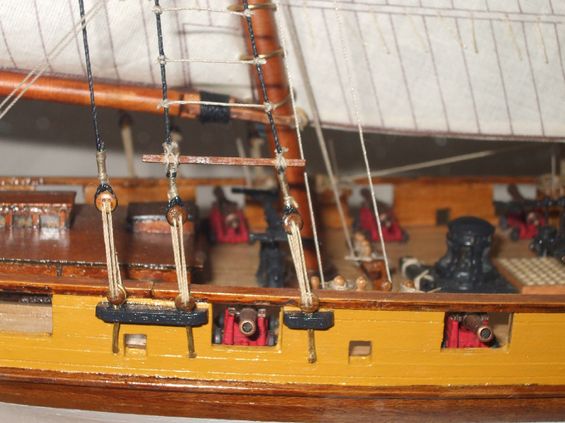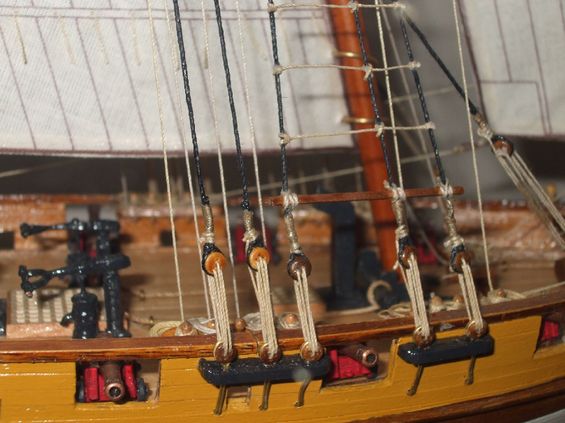Classic Ship Models 19
An AMATI photograph of "Roger B Taney"
A PROFILE
A UNITED STATES REVENUE CUTTER 1833
In the early part of the 19th century, the United States Revenue Service had thirteen cutters built of the Morris-Taney class. They were the backbone of the Service for more than a decade. Samuel Humphreys designed a number of them to perform roles as diverse as fighting ships, privateers, combating smugglers and operating in conjunction with their naval forces. The design was based on the naval schooner concept.
The vessels built by the New York shipyard of Webb and Allen were designed by Isaac Webb, a naval architect of considerable skill and who enjoyed a fine reputation in the maritime industry. HIs design resembled Humphreys' to a degree but had one less port. It also had a new rudder system whereby a half gear wheel was directly connected to a pinion fixed on the wheel shaft. In fact, the fine lines of these vessels were influential in the base design of the famous Baltimore Clippers referred to in this document. The Roger B Taney was one of those vessels which, as is said, influenced the design of the famous yacht "America" of 1851.
The Roger B Taney was launched on 26th December 1833 and commissioned in January 1834. Her home ports were Norfolk, Virginia - Eastport, Maine - and Savannah, Georgia. She served in these ports in various roles until she was severely damaged by a lightning strike off Tybee Island. The Government was forced to sell the vessel in 1858.
General Characteristics
Class and Type: Schooner Displacement 112 tons
Length: 73.4 ft Beam: 20.6 ft
Draft 9.7 ft Propulsion wind
Complement: 20-24 Armament 6 x 12 pounders
THE MODEL
THE MODEL
The "Roger B Taney"
A United States Revenue Cutter 1833
This is another neat and beautifully designed model from the Amati company of Italy. Its graceful lines with a clipper bow and transom stern were almost revolutionary in its time and - together with a large span of canvas - made it fast and lethal and well equipped for the job it was designed to perform. One can see immediately its potential for being the forerunner of the larger clipper ships in latter years.
The model is rather unique it that it has a resin hull which is then individually planked in a similar way to other models. Although not the usual preference of most dedicated modellers, it does have the advantage of producing a blemish free hull and is much easier to plank. The planks are glued for the full length rather than relying on being glued to frames.
All the deck fittings supplied are first class and so authentic - especially the steering system described in the Profile. The rigging is tidy and very straightforward. Being one of my earlier models, sails were attached and with the raking masts, look very impressive without detracting from the view of the rigging. There are ten cannons, 5 per side, which were easy to place and the deck sufficiently clear to place all the other fittings. It gave an ideal opportunity to practice and place neatly coiled ropes in the appropriate spots. This model would bring great joy, on completion, to the modeller with limited experience.
Statistically the model is on a 1:60 scale. She is 680 mms long overall with a height from keel to mast top of 590 mms. The construction time was approximately 5 months of leisure time.
Another view of the model of Roger B Taney encased, showing the simple ratlines, cannons and other deck fittings
Roger B Taney showing the cannons, foremast shrouds, the ratlines and the pumps on deck




